
It was less than 40 hours after filing my last column — detailing the existential dangers of three-dollar wine — that I found myself in New York’s famed Union Square Café, having lunch with my agent/producer/social better. We were talking about beer and mescal and vino, and he settled on an Italian wine he’d discovered while mooning around northern Italy with a more profitable client — because that’s the sort of life he leads. What he’s doing with me, I have no idea.
He says, “It’s an $80 bottle of wine, but it drinks like a $120 bottle.”
Well, I’ve certainly moved up in the world. What he ordered was a Roero Arneis — one of the stars of Italian white wines. You might want to write that down, because you likely won’t see a lot of it. But it is well worth remembering.
I’m generally pretty hard on Italian reds, mostly because of the sangiovese grape, which requires a big loud bolognaise with lots of acidic tomatoes to bring whatever gets kick-started on the palate back into balance. Historically, Italian wine-making regions have not been subject to regulation with as much pedantic gusto as their Gallic cousins in France. And it showed. Italian wines have long suffered a reputation for being harsh and raw.
The whites, however, are another story. Enter the arneis — a grape varietal that is commonly found in the hills of the Roero — that was all but extinct when it was rediscovered in the 1980s, following the Judgment of Paris. Not the one in Greek mythology that started the Trojan War, but a blind wine-tasting in 1976 wherein the Francophile wine establishment inadvertently ranked California wines higher than French ones. They’re still mad about it. The aftershock was that if great wine could be made in California, then where else?
Certainly in Italy’s historic Piedmont region. It is one of the most beautiful places on Earth, what my sister-in-law calls “maybe France, maybe Italy.” It is famous for its bold reds like the Barbera or Nebbiolo.
The arneis is a dry subtle grape with a fantastic aroma. It has become one of the stars of the region over the last 30 or so years, but because it is a low-yielding vine, it’s not likely to unseat the high-volume (and often excellent) pinot grigio. Roero Arneis is a wine with hints of those famous Peidmont white peaches, as well as crisp green apple and almond.
The last generation or so of Italian winemakers has stepped up its game with massive overhauls in both technique and equipment. Not the least of which is modern temperature control and stainless steel vats. The reason your grandparents avoided Italian wines probably had something to do with the use of concrete vats. They are hard to clean.
Ironically, it is the stainless steel that preserves some of the minerality of the Roero Arneis. That’s wine-speak for “tastes like a rock.” But picture the sort of stone God might have as a pet rock. I mention the minerality because it is so much a part of the profile that some winemakers, like Giovanni Almando, label theirs “vigne sparse” in reference to the dry, sandy soil in which it’s grown in the foothills of the Alps.
Due to its popularity, though, production has expanded beyond the patch of northern Italy with a few experiments with the grape in the U.S., Australia, and New Zealand. You can get a lovely Vietti Roero Arneis around town at about $24.99, and it’s worth checking out. It’s one of those really perfect summer wines — used as an aperitivo wine in Tuscany.
Or at least that’s what I was told at lunch. And being a Southerner, I tend to believe anything I’m told in lower Manhattan.

